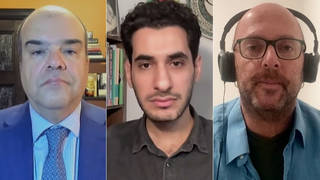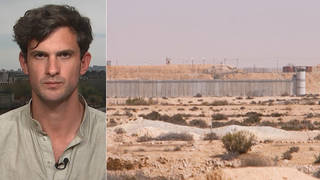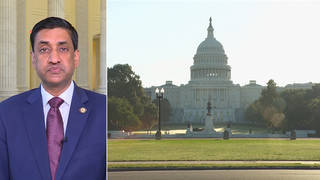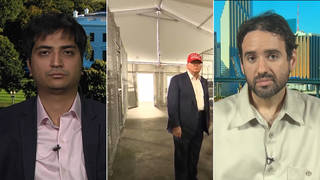
Guests
- James Galbraithan economist and professor of public affairs and government at the University of Texas. His most recent book is The Predator State: How Conservatives Abandoned the Free Market and Why Liberals Should Too.
Treasury Secretary Timothy Geithner outlined plans Thursday to rewrite the nation’s financial rules as part of what the Wall Street Journal described as the most comprehensive changes to financial market regulation since the New Deal. Geithner’s plan includes the creation of a single regulator to monitor any firm whose failure could threaten the financial system. We speak with economist James Galbraith. [includes rush transcript]
Transcript
JUAN GONZALEZ: Treasury Secretary Timothy Geithner outlined plans Thursday to rewrite the nation’s financial rules as part of what the Wall Street Journal described as the most comprehensive changes to financial market regulation since the New Deal. Geithner’s plan includes the creation of a single regulator to monitor any firm whose failure could threaten the financial system.
TIMOTHY GEITHNER: Our system failed in basic fundamental ways. Compensation practices rewarded short-term profits over long-term return. Pervasive failures in consumer protection left many Americans with obligations they did not understand and could not sustain. The huge apparent returns to financial activity attracted fraud on a dramatic scale. Market discipline failed to constrain dangerous levels of risk-taking throughout the system. New financial products were created that — to meet demand from investors, but the complexity outmatched the risk management capabilities of even the most sophisticated institutions in the world.
To address this will require comprehensive reform, not modest repairs at the margin, but new rules of the game. And the new rules must be simpler and more effectively enforced. They must produce a more stable system, one that protects consumers and investors, rewards innovation, and is able to adapt and evolve with changes in the structure of our financial system.
JUAN GONZALEZ: Treasury Secretary Geithner also called for extending federal regulation for the first time to all trading in financial derivatives and credit default swaps that are blamed for much of the economic crisis. Under his plan, the government would also be empowered to take over major non-bank financial firms, such as insurers and hedge funds, if deemed necessary.
AMY GOODMAN: Geithner’s call for new regulations on Wall Street comes just days after he introduced a controversial proposal for the government to form public-private partnerships to take troubled assets off the books of banks.
To talk about these stories, the economist and writer James Galbraith joins us from Austin, Texas. He’s professor of public affairs and government at the University of Texas. His most recent book is The Predator State: How Conservatives Abandoned the Free Market and Why Liberals Should Too. His latest article “No Return to Normal” appears in the current issue of the Washington Monthly.
You are concerned about Tim Geithner’s plans over the last few days. Lay out your concerns, Professor Galbraith.
JAMES GALBRAITH: Public-private partner [inaudible] —-
AMY GOODMAN: Well, if you can possibly bear with yourself hearing -— with you hearing yourself reverberating in your ear — we’re not hearing that echo.
JAMES GALBRAITH: [inaudible] for transferring the risk that the underlying assets will go bad from the banks themselves by getting them off their books, largely to the Federal Deposit Insurance Corporation, which would offer a non-recourse loan for about 85 percent of the value of the assets that are being purchased. And the difficulty I have with that is that I think that plan is based upon an excessively optimistic assessment of the prospects for those assets.
And what Secretary Geithner said yesterday, that these assets were issued to consumers that in many cases did not understand what they were getting into and that they were magnets for fraud, both of those remarks are absolutely true. But once one, I think, takes that into account, effectively, you realize that the prospects for capital losses on those assets are really very, very high, the recovery rates are likely to be quite poor, and that we’ve already seen that with banks that the FDIC has taken over, specifically with IndyMac in California.
And so, that suggests to me that this is a — this plan would have the effect of transferring the losses to the taxpayers without exacting any serious consequences for the banks that essentially created the fiasco. And since the financial system has to shrink one way or another, if you protect the largest banks, as I think the Treasury plan does, then the consequences will fall on other financial institutions, which are relatively well managed and which did not take part in the — to the same degree in the subprime debacle. And those would tend to be smaller banks. And I think it’s really — it’s likely to be — promote an unmanageable banking structure, if we go that route.
And secondly, it’s not going to solve the problem which everybody would like to see solved, which is the complete breakdown of the credit system. It’s not going to bring the economy back to life by the vehicle of new bank spending.
JUAN GONZALEZ: Well, in your article, “No Return to Normal,” you make the point that it appears that the Obama administration is still dealing with this primarily as a crisis of flow in credit and not a crisis of the actual collapse of the financial system. And could you explain precisely in what way they are missing that fundamental point?
JAMES GALBRAITH: Well, we hear this expression that credit flows are blocked and that there is a need to get credit flowing again. And it really is — it’s a metaphor. And I think it’s a revealing metaphor, if it in fact reflects the way in which high officials of the government are thinking about the problem. The idea of a flow, of course, is something that comes from on high and goes down below. A blockage is a kind of plumbing problem.
The difficulty is credit isn’t like that. Credit is a bilateral contract. It’s a relationship between a lender and a borrower. And the problem is not that the lenders don’t have money to lend. The problem is, in very large part, that there are no prospects or very few prospects for profit in the economy, and therefore, borrowers, business borrowers aren’t coming in to ask for loans for economic expansion. And secondly, on the residential and household side, households are strapped. They’re desperate to hang onto the cash that they have. They’re trying to pay down their debts, not to get into new debts. For that reason, they’ve stopped buying cars and stopped buying houses for the time being. And then, even if they did want to come in, in many cases, they don’t have the collateral that they had last year or the year before, because the value of their houses has fallen. So those are the problems of the underlying economy, the consequences, to be sure, of the collapse of the housing — of the subprime housing bubble.
But they’re not problems that can be solved by simply adding new reserves, new capital, to the banks. And, in fact, we’ve seen that the banks are flush with cash. They’re largely sitting on it. And to the extent that they’re not sitting on it, they may be using it for things like acquisitions, acquisitions of other banks, for instance. So the effect of the program is actually to expand the market share and the market power of the largest institutions. And again, to me, that is deeply problematic, because we’ve got banking institutions that are so large at this point, they’re so complicated, so opaque, so deeply involved in offshore tax havens, shell corporations and complicated derivatives, that they can’t be managed, let alone regulated.
The top executive officers didn’t know, to a very large extent, or at least by their own testimony, they didn’t know, the risk exposure of their own institutions. And they made catastrophic mistakes on the scale of tens and scores of billions of dollars, because they didn’t have effective internal controls. And if you don’t have the internal controls, there’s just no way that an outside regulator can get a grip on the systemic risk that the institution may be causing. So my view is, if you want to have a system that has appropriate checks and balances, the institutions in that system have to be of a scale such that the regulators, which Secretary Geithner properly said yesterday must be strengthened, but they also have to have the basic capacity to deal with the institutions that they’re regulating.
JUAN GONZALEZ: In his column in today’s New York Times, Paul Krugman raises similar points, but I guess in a different — from a different perspective. He raises the question that the administration is attempting basically to put Humpty Dumpty back together again, to restore this process of securitization that became so prevalent among banks, securitizing mortgages and auto loans and credit card debt. And he says that they’re not confronting the fact that that method, that has reigned now in banking for decades now, has collapsed and is a failure, and something else must be done. Do you agree with that?
JAMES GALBRAITH: Well, I would take a modest exception to it, by way of going a bit further. It is not the case that the securitization of subprime mortgages is a long-term phenomenon. It is something which has been a practice, prevalent practice, for about eight years at the maximum. Before that, the markets would not have contemplated the massive securitization of loans which are subprime.
What does the subprime mean? Subprime means loans that do not meet the standards for a normal mortgage loan that could be taken up by the secondary markets, by Fannie Mae and Freddie Mac. And so, those loans are characteristically loans that don’t have documentation, that don’t have proper credit histories on the borrowers, and where the appraisals seem a little funny. And in the case of the subprime loans in the middle of the decade, there was systematic fraud in the appraisals, systematic overstatement of what the houses were worth, because the bigger the loan that you gave, the bigger fee you could book. And so, these are markets that should never — historically didn’t exist and should not have been allowed to develop. They’re intrinsically unsafe. And so, from that point of view, Paul, of course, is exactly right, that the — trying to restore these markets, trying to go back to the normal of two years ago, is really trying to go back to a situation that is historically abnormal and intrinsically unstable.
And in some ways, you can say what the Treasury plan actually is is a way of creating a new derivative, a new bond, if you like, which the Treasury has half the capital and provides 85 percent of the value of the purchase in the form of a low-interest, non-recourse loan that’s designed to make the purchase of these so-called assets from the banks a highly profitable proposition for hedge funds and private equity investors and others who are in a position to risk their capital without having to face fiduciary consequences.
And so, you know, it’s something which — I suppose there may be investors out there who think that they could make money off of this, but I’ll tell you who it would be particularly attractive to, if they could get away with it, and that is the banks themselves or people acting on their behalf, because what it would mean is that, in effect, the banks can transfer — someone acting on behalf of a bank could arrange for the transfer of a dollar’s worth of these bad securities at face value for seven-and-a-half cents of risk. And that means that you’re really, in effect, creating a conduit, which would just take these losses off of the books of the banks, put them on the books of the Federal Deposit Insurance Corporation. And I would say that would solve the problem for the banks, but it wouldn’t solve the problem for anybody else.
AMY GOODMAN: Professor Galbraith, we want to thank you very much for being with us. James Galbraith is an economist, professor of public affairs and government at the University of Texas, Austin. His most recent book is The Predator State: How Conservatives Abandoned the Free Market and Why Liberals Should Too.












Media Options